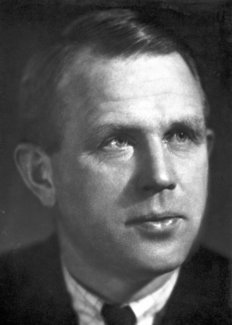Artturi Virtanen
Biographical

Artturi Ilmari Virtanen was born in Helsinki on the 15th of January, 1895, as the son of Kaarlo Virtanen and Serafiina Isotalo. He was educated at the Classical Lyceum at Viipuri, Finland. After finishing school, he studied chemistry, biology, and physics at the University of Helsinki, where he took his M.Sc. in 1916 and obtained his D.Sc. in 1919. Subsequently he studied physical chemistry in Zurich in 1920 under G. Wiegner, bacteriology in Stockholm in 1921 under Chr. Barthel, and enzymology in Stockholm during 1923-1924 under H. von Euler. Since 1923, his interest turned to biochemistry.
He was first-assistant of the Central Laboratory of Industries at Helsinki during 1916-1917, and chemist in the Laboratory of Valio, Finnish Cooperative Dairies’ Association, during 1919-1920. In 1921 he became Director of this laboratory, and in 1931 of the Biochemical Research Institute at Helsinki. After having been docent in chemistry at the University of Helsinki since 1924, he was appointed Professor of Biochemistry at the Finland Institute of Technology at Helsinki in 1931, and at the University of Helsinki in 1939. Since 1948 he has been member and President of the State Academy of Science and Arts in Finland.
Professor Virtanen is a member of the Finnish, Norwegian, Swedish, Flemish, Bavarian, and Pontifical Academies of Science, and of the Swedish and Danish Academies of Engineering Sciences. He is an honorary member of learned societies in Finland, Sweden, Austria, Edinburgh, and the U.S.A., and holds honorary degrees of the Universities of Lund, Paris, Giessen, and Helsinki, the Royal Technical College at Stockholm, and the Finland Institute of Technology. Numerous medals and other distinctions have been conferred upon him from Sweden, Finland, Belgium, and Italy.
Virtanen established the indispensability of cozymase in lactic and propionic acid fermentations, as well as the phosphorylation of sugar (1924). In these works the similarity of different fermentation processes as to the first stages in the decomposition of sugar became apparent. Together with his collaborators he continued the fermentation experiments, special attention being paid to the mechanism of different bacterial fermentations. The fermentation of dioxyaceton to glycerol and glyceric acid in the presence of phosphates by the effect of Coli bacteria (1929) was the first sugar fermentation which was elucidated chemically from beginning to end. In this work attention was also paid to the adaptive formation of enzymes, which phenomenon his collaborator H. Karström treated in great detail in his doctor’s thesis (constitutive and adaptive enzymes). The phenomenon of adaptation, and in connection with it the uptake of nutrients by cells, is still subjected to investigations in his laboratory. The concept that almost all proteins in bacterial cells are enzyme proteins led to investigations on the relation between the protein content and enzymic activity of cells.
Since 1925, the biological nitrogen fixation which takes place in the root nodules of leguminous plants has been subjected to many-sided investigations in his laboratory. The importance of the red pigment, leghaemoglobin, in active root nodules for the fixation of nitrogen was proved.
The formation of vitamins in plants, as well as the ability of plants to utilize organic nitrogen compounds as their nitrogen source, have been treated in many publications from his laboratory.
Since the end of the 1940’s, the chemical composition of higher plants has been given special attention in his laboratory. A large number of new amino acids have been isolated from different plants, and have been characterized chemically. Numerous organic sulphur compounds, which may be of importance for the nutrition of man and domestic animals, have also been isolated from vegetables and fodder plants.
The application of biochemistry to agriculture and the dairy industry belongs to the practical activities of his laboratory. Among works performed in this field are the creation of a theoretical basis for the preservation of fresh fodder and the development of a practical method on this basis (the AIV method), with the aim to promote an effective utilization of protein-rich crops, and to produce milk of the same vitamin content in winter as that produced on summer pastures. Investigations aiming at the improvement of the quality of dairy products also have to be mentioned as belonging to the field of applied research.
Virtanen married Lilja Moisio in 1920; they have two sons, Kaarlo and Olavi.
This autobiography/biography was written at the time of the award and first published in the book series Les Prix Nobel. It was later edited and republished in Nobel Lectures. To cite this document, always state the source as shown above.
Artturi Virtanen died on November 11, 1973.
Nobel Prizes and laureates
Six prizes were awarded for achievements that have conferred the greatest benefit to humankind. The 14 laureates' work and discoveries range from quantum tunnelling to promoting democratic rights.
See them all presented here.
